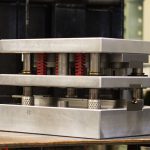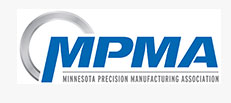 Stamping metal is a cold-forming process that uses dies and stamping presses to turn sheet metal into different shapes. Flat sheets of metal, also known as blanks, are fed into a sheet metal stamping press and formed into a new shape with the help of a tool and die. Stamping facilities and metal fabricators use pressure to shape and shear the material into the desired final shape for the product or component. The material is placed between die sections and stamped.
Stamping metal is a cold-forming process that uses dies and stamping presses to turn sheet metal into different shapes. Flat sheets of metal, also known as blanks, are fed into a sheet metal stamping press and formed into a new shape with the help of a tool and die. Stamping facilities and metal fabricators use pressure to shape and shear the material into the desired final shape for the product or component. The material is placed between die sections and stamped.
A metal stamping process, also known as pressing, is a high-speed, low-cost method for assembling metal parts in large quantities. Stamping operations can be performed with both short and long runs, and with other metal forming operations, and may include one or more of a series of more specific processes and techniques, such as:
● Punching
● Blanking
● Embossing
● Coining
● Bending
● Flanging
In punching and blanking, a die is used to cut the material into specific shapes. When a punch enters a die, a scrap of material is removed, effectively leaving a hole in the workpiece. Blanking, on the other hand, involves removing a workpiece from the primary material and using that removed piece as the desired workpiece.
In embossing, the raw blank is pressed against a die that contains the desired shape, or the blank is rolled through a roller die to produce a raised or recessed design.
The coining process involves stamping the workpiece between a die and a punch or press. In this way, the punch tip penetrates the metal and produces repeatable, accurate bends. Deep penetration also relieves internal stresses in the metal workpiece, which prevents springback.
The process of bending metal is used to form it into desired profiles, such as L, U, or V shapes. In metal bending, the plastic deformation results in stresses above the yield point but below the tensile strength. A single axis is typically bent.
Flanging is a process of introducing a flare or flange onto a metal workpiece through the use of dies, presses, or specialized flanging machinery.
In addition to stamping, metal stamping machines can cast, punch, cut, and shape metal sheets. The stamping machines can either be programmed or CNC controlled to ensure high precision and repeatability. EDM (electric discharge machining) and CAD (computer-aided design) programs ensure accuracy. A variety of die-making machines are available for stampings. Tooling for progressive, forming, compound and carbide stamping is available. Multiple pieces can be created on one piece simultaneously using progressive dies.
Volume metal component parts are produced using metal stamping machines. For the production of custom metal stampings, the machines operate custom die sets. Parts can be produced from a wide variety of materials with close tolerances by metal stamping.
There are three basic types of precision metal stampings:
Progressive Die Metal Stampings
The progressive die stamping process is perhaps the most common metal stamping process. The metal strip is progressively formed into your custom part as it travels through the die. Several different stations in the progressive dies shape or form the part as it is carried by the strip. Progressive stampings are generally the most affordable method of stamping. From 2 tons to 60 tons, we have a range of OBI and Straight Side presses capable of manufacturing close tolerance, precision stampings in a variety of metals and shapes. Metals with thicknesses of .002 to .250 inches and widths of .060 to 4.00 inches are available.
Deep Drawn Metal Stampings
We use stainless steel, brass, copper, nickel alloys and other metals according to customer specifications. Transfer presses and eyelet machines are used to fabricate deeply receded parts with separate stations of punches and dies. Metal stampings made from a flat metal strip are deep drawn parts. Cups are drawn or eyelet parts that have a depth that exceeds their width.
Multi-Slide Metal Stampings
Oftentimes, multi-slide or four-slide metal stampings are the most intricate parts with multiple bends or angles. These are generally wrapped or clamped parts. Additionally, multi-slide machines can run more than one die set at the same time and at different angles. We use these machines to manufacture most of our wire forms as well. With the ability to form a wide variety of wire and strip alloys into custom precision metal stamping parts, our Forming machines range from #00 four-slides to #35 multi-slides. As of now, we produce wire forms with a diameter up to .125 inches.





